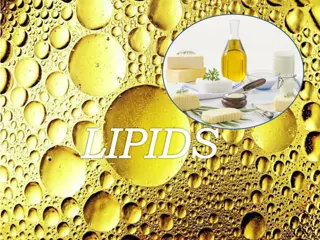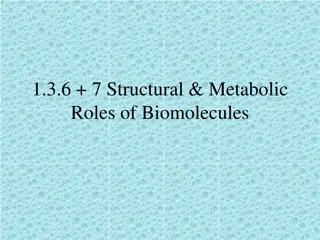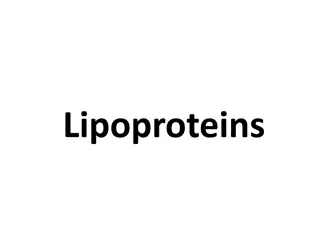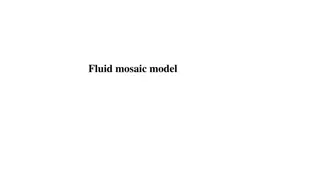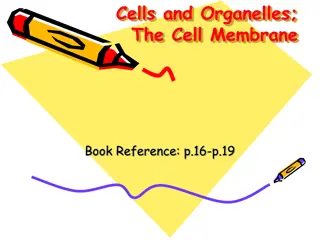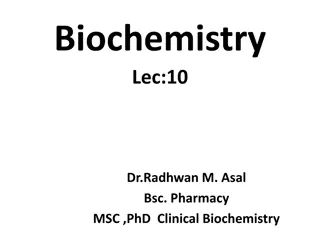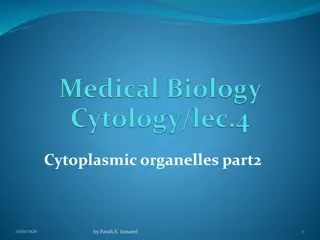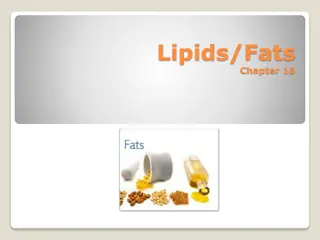Understanding Lipids: Properties, Functions, and Types
Lipids are a diverse group of organic compounds that include fats, oils, hormones, and components of cell membranes. They are vital for energy storage, structural roles in cell membranes, hormone synthesis, and organ protection. Lipids can be classified into different types such as waxes, triglyceri
11 views • 14 slides
Bacterial Cell Structure and Composition Overview
Bacterial cells exhibit variations in size, typically ranging from 0.75 to 1.5 micrometers. The cell envelope, comprising glycocalyx, cell wall, and cell membrane, plays crucial roles in protection and cell function. The cell membrane, a thin barrier rich in phospholipids and proteins, is integral t
1 views • 28 slides
Understanding the Importance of Phospholipids in Physiology
This educational material delves into the significance of phospholipids in physiological processes. Topics covered include the structure and functions of phospholipids, their role in membranes, signaling mechanisms, and non-membrane functions. The content also explores lipid compounds as a heterogen
0 views • 25 slides
Overview of Lipids: Classification and Biological Importance
Lipids are organic substances that play a crucial role in biological systems. They include simple lipids, complex lipids like phospholipids and glycolipids, and derived lipids. Simple lipids are esters of fatty acids with various alcohols, while complex lipids are sub-classified based on the type of
2 views • 38 slides
Understanding the Structural Roles of Biomolecules in Living Organisms
Explore the essential roles of carbohydrates, proteins, and lipids in cell structure and function. Learn how cellulose, keratin, myosin, phospholipids, and more contribute to the structural integrity and metabolic activities within living organisms. Discover the significance of these biomolecules in
4 views • 23 slides
Understanding Lipoproteins: Structures and Functions
Lipoproteins are compound lipids formed by the aggregation of neutral and amphipathic lipids with proteins (apoproteins). They serve as vehicles for transporting lipids through the bloodstream and lymphatic system, acquiring polarity due to their hydrophilic properties. These macromolecules are synt
0 views • 51 slides
Understanding Lipid Compounds and Their Physiological Significance
Explore the world of lipid compounds and their vital roles in the body, including serving as a major energy source, structural components of cell membranes, and key regulatory molecules. Learn about various types of lipids, such as fatty acids, phospholipids, and lipoproteins, and their relevance to
0 views • 24 slides
Understanding the Fluid Mosaic Model of Plasma Membrane Structure
The fluid mosaic model proposed by S.J. Singer and Garth L. Nicolson describes the structure of the plasma membrane as a fluid combination of phospholipids, cholesterol, proteins, and carbohydrates. This model explains how phospholipids form a stable barrier, the role of saturated and unsaturated fa
2 views • 6 slides
Understanding Cell Membrane Structure and Proteins
Exploring the basic structure of membranes, the distribution of proteins within the membrane, intrinsic vs. extrinsic proteins, the fluid mosaic model, phospholipids forming the bilayer, the role of hydrophilic and hydrophobic parts in phospholipids, polysaccharides, and the differences between glyc
0 views • 18 slides
Understanding Lipid Biochemistry: A Comprehensive Overview
Lipids are a diverse group of compounds crucial for various biological functions. They include fats, oils, steroids, and waxes with unique properties essential for energy storage, insulation, and nerve function. Knowledge of lipid biochemistry is pivotal in understanding areas like obesity, diabetes
0 views • 38 slides
Understanding Lipids: Nature's Flavor Enhancers
Lipids, a category of organic compounds, are essential for enhancing flavors in food. They contain carbon, hydrogen, and oxygen but do not dissolve in water. Lipids come in three general types - triglycerides, phospholipids, and sterols. They consist of glycerol and fatty acids, with variations like
0 views • 38 slides
Functions and Medical Applications of Smooth Endoplasmic Reticulum (SER)
Smooth Endoplasmic Reticulum (SER) is a vital organelle involved in various cellular functions such as synthesizing phospholipids, detoxifying drugs, producing hormones, and aiding in lipid metabolism. Its role in processing bilirubin helps prevent jaundice, with implications for newborn health. The
0 views • 28 slides
Role of Lipids in Plant-Pathogen Interaction
Lipids play a central role in signal molecule production for actively modifying the invasive capabilities of pathogens and the defensive mechanisms of plants during inter and intra-plant-pathogen interactions. They are essential constituents of membranes, providing structural support and serving div
0 views • 43 slides
Understanding Lipids and Fats in Nutrition
Lipids are essential compounds found in every living cell, categorized into triglycerides, sterols, and phospholipids. Triglycerides play a vital role in absorbing and transporting vitamins, energy storage, and cushioning organs. Understanding the difference between saturated and unsaturated fats is
0 views • 16 slides
